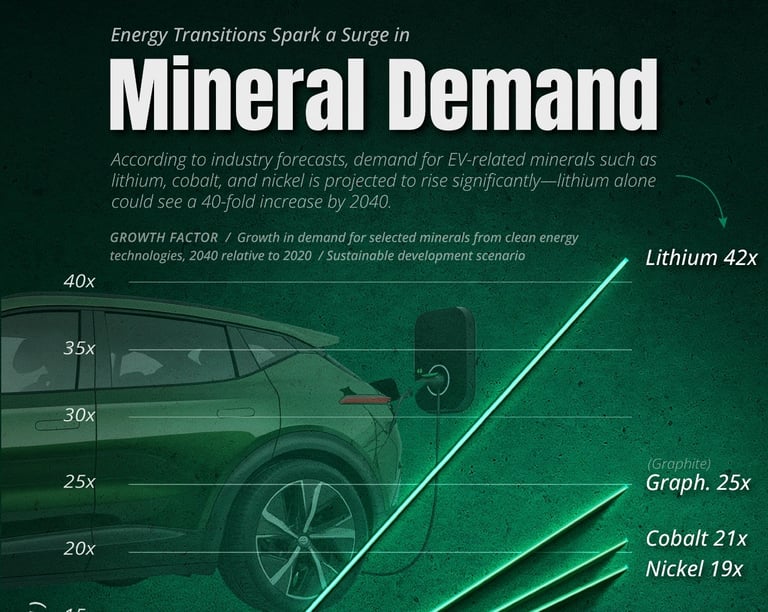Market Supply and Demand Research Report:Energy Transition Expected to Fuel Surging Demand for Critical Minerals
Xuan-Ce Wang
3/23/20255 min read


Key Points
Demand Surge: Critical minerals are projected to see significant demand growth, with lithium leading (42x) and copper the least (2x).
Drivers: Widespread adoption of EV batteries, renewable energy technologies, and energy storage solutions.
Market Impact: Supply shortages, price volatility, geopolitical risks, and environmental challenges.
Strategies: Investment in mining and refining, supply chain diversification, sustainability, innovation, and collaboration.
Conclusion: Securing sustainable supply of critical minerals is essential for the global energy transition.
Abstract:
This report examines the impact of the global energy transition on the demand for critical minerals (lithium, graphite, cobalt, nickel, manganese, rare earth elements, and copper). By 2040, demand is projected to surge, with lithium increasing 42-fold, graphite 25-fold, cobalt 21-fold, nickel 19-fold, manganese 8-fold, rare earth elements 3-fold, and copper 2-fold. This growth is driven by electric vehicle batteries, renewable energy technologies, and energy storage solutions. The report explores market opportunities, challenges, and strategies, highlighting the need for investment, innovation, and collaboration to ensure sustainable supply.
1. Introduction
As the global push toward clean energy intensifies, demand for certain minerals and metals essential to this transition is projected to surge by 2040. The infographic "Energy Transitions Spark a Surge in Mineral Demand," created by Mining Visuals in collaboration with In Gold We Trust and based on International Energy Agency (IEA) data, highlights the exponential growth expected for seven critical minerals—lithium, graphite, cobalt, nickel, manganese, rare earth elements (REE), and copper. This growth is driven primarily by the rapid adoption of electric vehicle (EV) batteries, renewable energy technologies (such as wind turbines and solar power), and large-scale energy storage solutions.
This report examines the projected demand increases for these minerals, their roles in clean energy applications, and the resulting pressures on supply chains. It also addresses the opportunities and challenges facing the market, including geopolitical risks, environmental concerns, and the need for investment and collaboration to ensure a sustainable supply. Securing these resources efficiently will be pivotal to the success of the global energy transition.
2. Projected Demand Growth for Critical Minerals
The infographic provides growth factors for each mineral, representing the increase in demand by 2040 compared to 2020 levels under a sustainable development scenario. These projections are visualized as multiples of 2020 demand (indexed at 1), with the following growth factors:
• Lithium: 42x
• Graphite: 25x
• Cobalt: 21x
• Nickel: 19x
• Manganese: 8x
• Rare Earth Elements (REE): 3x
• Copper: 2x
These figures highlight the varying degrees of demand growth, with lithium leading the pack and copper experiencing the smallest relative increase. Below, we explore each mineral’s role in the energy transition and the market dynamics at play.
a) Lithium: The Cornerstone of EV Batteries
Growth Factor: 42x
Lithium is set to experience the most dramatic demand surge, potentially growing over 40 times from 2020 levels (specifically 42x per the infographic). This leap reflects its critical role in lithium-ion batteries, which power electric vehicles and store renewable energy. With EV adoption accelerating globally—driven by government incentives, consumer demand, and technological advancements—lithium demand is poised to skyrocket.
Market Implications:
Supply Expansion: Current lithium production is concentrated in Australia, Chile, and China. Meeting a 42-fold increase will require significant new mining projects and refining capacity.
Price Pressures: Past supply bottlenecks have led to lithium price volatility, a trend that could intensify without proactive investment.
Sustainability: Extraction methods, such as brine evaporation, raise concerns about water use and environmental impact, necessitating sustainable practices and recycling efforts.
b) Graphite: Essential for Battery Anodes
Growth Factor: 25x
Graphite demand is projected to rise 25 times, driven by its use in the anodes of lithium-ion batteries. As EV production scales up, graphite will remain a vital component.
Market Implications:
Supply Concentration: China dominates global graphite production, posing supply security risks. Diversifying sources will be key.
Innovation: Synthetic graphite and alternative anode materials are being explored, but natural graphite will likely retain its prominence in the near term.
c) Cobalt: A Key Cathode Component
Growth Factor: 21x
Cobalt, used in battery cathodes, is expected to see demand increase by 21 times. Its role in enhancing battery stability and performance makes it critical for EVs.
Market Implications:
Ethical Challenges: Over 70% of cobalt comes from the Democratic Republic of Congo (DRC), where mining practices have faced scrutiny over labor and environmental issues. Ethical sourcing is a growing priority.
Substitution Trends: Efforts to reduce cobalt in batteries (e.g., via nickel-rich chemistries) may temper demand growth, though it remains essential for now.
d) Nickel: Powering High-Energy Batteries
Growth Factor: 19x
Nickel demand is forecasted to grow 19 times, driven by its use in high-energy-density battery cathodes, particularly in nickel-manganese-cobalt (NMC) chemistries favored by EV manufacturers.
Market Implications:
High-Purity Demand: Battery-grade (Class 1) nickel is in short supply, as much of the current production serves stainless steel markets. Expanding Class 1 nickel output is a priority.
Geopolitical Factors: Indonesia’s rise as a nickel powerhouse introduces both opportunities and environmental concerns tied to mining practices.
e) Manganese: Supporting Battery Chemistries
Growth Factor: 8x
Manganese demand is expected to increase 8-fold, owing to its use in NMC battery cathodes and other chemistries that enhance battery performance and cost-effectiveness.
Market Implications:
Abundant Supply: Manganese is more widely available than other minerals, reducing supply risks. However, refining it to battery-grade purity will require investment.
f) Rare Earth Elements (REE): Enabling Wind and Motors
Growth Factor: 3x
Rare earth elements, vital for permanent magnets in wind turbines and electric motors, are projected to triple in demand.
Market Implications:
Supply Dominance: China controls over 80% of REE production, creating supply chain vulnerabilities. Efforts to develop alternative sources (e.g., in Australia and the U.S.) are underway but face hurdles.
Recycling Potential: REE recycling and substitute materials could mitigate demand pressures over time.
g) Copper: The Backbone of Infrastructure
Growth Factor: 2x
Copper demand is anticipated to double, driven by its widespread use in electrical wiring, renewable energy systems, and EV charging infrastructure.
Market Implications:
Supply Constraints: Declining ore grades and water scarcity in key regions like Chile challenge production expansion.
3. Market Opportunities and Challenges
Opportunities
The surging demand for critical minerals presents significant opportunities:
Economic Growth: Expanding mining and refining operations can boost economies, particularly in resource-rich regions.
Innovation: The need for sustainable supply chains is spurring advancements in recycling, battery technologies, and alternative materials.
Clean Energy Acceleration: A robust mineral supply will enable faster deployment of EVs and renewables, supporting global decarbonization goals.
Challenges
However, several hurdles must be addressed:
Supply Chain Pressures: The rapid demand growth outpaces current production capacity, risking shortages and price spikes.
Geopolitical Uncertainties: Concentration of mineral supply in a few countries (e.g., China for graphite and REE, DRC for cobalt) introduces risks of trade disruptions or export restrictions.
Environmental Concerns: Mining and processing these minerals often involve high water use, carbon emissions, and habitat disruption. Sustainable practices are critical to maintaining public and regulatory support.
Investment Needs: Scaling supply requires billions in capital for new mines, refineries, and technologies—investments with long lead times.
4. Strategies to Meet Growing Demand
To sustainably meet this demand, the industry must adopt a multi-faceted approach:
Investment in Mining and Refining: Significant funding is needed to expand production capacity, particularly for high-growth minerals like lithium and nickel.
Supply Chain Diversification: Developing mining operations in new regions and reducing reliance on single suppliers will enhance resilience.
Sustainability Initiatives: Adopting low-impact mining techniques, improving recycling rates (e.g., for EV batteries), and addressing social concerns will ensure long-term viability.
Collaboration: Governments, industry leaders, and investors must partner to align policies, share risks, and fund critical projects. For example, subsidies or trade agreements could incentivize supply growth.
Technological Innovation: Research into alternative battery chemistries (e.g., solid-state batteries) and material substitutes could reduce dependence on certain minerals over time.
Conclusion
The global energy transition is fueling an unprecedented surge in demand for critical minerals, with lithium leading at a projected 42-fold increase by 2040, followed by graphite (25x), cobalt (21x), nickel (19x), manganese (8x), rare earth elements (3x), and copper (2x). These minerals are the backbone of EV batteries, renewable energy technologies, and energy storage solutions—technologies central to achieving a low-carbon future.
However, this demand boom brings both opportunities and challenges. Expanding EV production and renewable energy projects are increasing pressure on supply chains, while geopolitical uncertainties and environmental concerns complicate sourcing efforts. To meet this growing need sustainably, substantial investment in mining, refining, and new technologies is essential. Collaboration between governments, industry leaders, and investors will be key to ensuring a stable and responsible supply.
Ultimately, securing these critical minerals efficiently will shape the success of the energy transition, unlocking a cleaner, greener future while addressing the complex market dynamics ahead.








